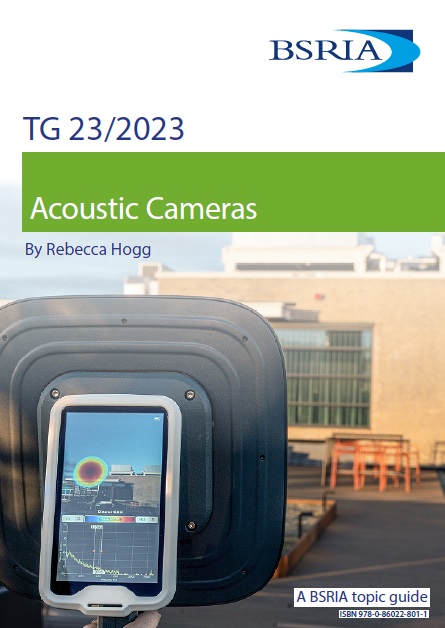Acoustic Cameras (TG 23/2023)
Acoustic Cameras (TG 23/2023) was written by Rebecca Hogg and published by BSRIA in July 2023.
This topic guide provides a broad overview of acoustic cameras – a technology which can be used to visually identify noise sources. It explains how an acoustic camera works, some of the applications of acoustic cameras, and the advantages and disadvantages of using acoustic cameras over other technologies.
Traditionally a sound level meter is used to measure noise levels, in decibels. Investigating noise sources can be achieved by systematically turning on and off noise sources and by using other investigation techniques. When troubleshooting building services systems, there are other investigation techniques that can be used such as vibration monitoring, air and water flow rate measurements, and pressure measurements. When using these, it may also be necessary to turn off systems and dismantle components. The advantage of using an acoustic camera over such investigation techniques is that an acoustic camera does not require systems to be broken into or sensors to be physically attached to a system.
An acoustic camera incorporates an array of microphones. It builds up an image by processing the information received at each of the microphones in the array, which all receive sound waves from the same source at slightly different times. The image produced uses colours to represent sound pressure levels. Typically, bright colours such as yellow are used to represent areas producing the most intense sound whereas darker colours such as purple are used to represent areas producing the least intense sound. The specific colours used, and the range of sound pressure levels represented by these colours, can be selected in the software used by acoustic cameras.
You can download the guide at: https://www.bsria.com/uk/product/rgooar/acoustic_cameras_tg_232023_a15d25e1/
--BSRIA
[edit] Related articles on Designing Buildings
Featured articles and news
One of the most impressive Victorian architects. Book review.
RTPI leader to become new CIOB Chief Executive Officer
Dr Victoria Hills MRTPI, FICE to take over after Caroline Gumble’s departure.
Social and affordable housing, a long term plan for delivery
The “Delivering a Decade of Renewal for Social and Affordable Housing” strategy sets out future path.
A change to adoptive architecture
Effects of global weather warming on architectural detailing, material choice and human interaction.
The proposed publicly owned and backed subsidiary of Homes England, to facilitate new homes.
How big is the problem and what can we do to mitigate the effects?
Overheating guidance and tools for building designers
A number of cool guides to help with the heat.
The UK's Modern Industrial Strategy: A 10 year plan
Previous consultation criticism, current key elements and general support with some persisting reservations.
Building Safety Regulator reforms
New roles, new staff and a new fast track service pave the way for a single construction regulator.
Architectural Technologist CPDs and Communications
CIAT CPD… and how you can do it!
Cooling centres and cool spaces
Managing extreme heat in cities by directing the public to places for heat stress relief and water sources.
Winter gardens: A brief history and warm variations
Extending the season with glass in different forms and terms.
Restoring Great Yarmouth's Winter Gardens
Transforming one of the least sustainable constructions imaginable.
Construction Skills Mission Board launch sector drive
Newly formed government and industry collaboration set strategy for recruiting an additional 100,000 construction workers a year.
New Architects Code comes into effect in September 2025
ARB Architects Code of Conduct and Practice available with ongoing consultation regarding guidance.
Welsh Skills Body (Medr) launches ambitious plan
The new skills body brings together funding and regulation of tertiary education and research for the devolved nation.
Paul Gandy FCIOB announced as next CIOB President
Former Tilbury Douglas CEO takes helm.
























